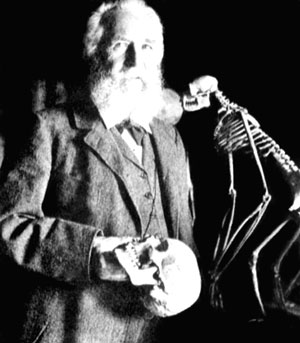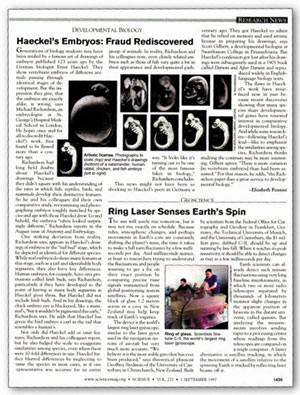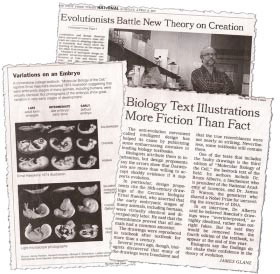Ernst Haeckel, one of the foremost charlatans in the history of science.
8. What Scientific Forgery Is The Myth That "Human Embryos Have Gills" Based On?
The thesis that living things go through various stages in their mothers' wombs that can be seen as evidence for evolution has a special position amongst the unfounded claims of the theory of evolution. That is because the thesis, known as "recapitulation" in evolutionist literature, is more than a scientific deception: It is a scientific forgery.
Haeckel's recapitulation superstition
 |
The term "recapitulation" is a condensation of the dictum "ontogeny recapitulates phylogeny," put forward by the evolutionary biologist Ernst Haeckel at the end of the nineteenth century. This theory of Haeckel's postulates that living embryos re-experience the evolutionary process that their pseudo-ancestors underwent. He theorised that during its development in its mother's womb, the human embryo first displays the characteristics of a fish, then those of a reptile, and finally those of a human. The claim that the embryo possesses "gills" while it develops stems from this thesis.
However, this is utter superstition. Scientific developments in the years since recapitulation was first broached have enabled studies to be made of just how valid it is. These studies have shown that the recapitulation doctrine has no other basis than evolutionists' imaginations and deliberate distortions.
It is now known that the "gills" that supposedly appear in the early stages of the human embryo are in fact the initial phases of the middle-ear canal, parathyroid, and thymus. That part of the embryo that was likened to the "egg yolk pouch" turns out to be a pouch that produces blood for the infant. The part that was identified as a "tail" by Haeckel and his followers is in fact the backbone, which resembles a tail only because it takes shape before the legs do.
These are universally acknowledged facts in the scientific world, and are accepted even by evolutionists themselves. George Gaylord Simpson, one of the founders of neo-Darwinism, writes:
Haeckel misstated the evolutionary principle involved. It is now firmly established that ontogeny does not repeat phylogeny.45
The following was written in an article in New Scientist dated October 16, 1999:
[Haeckel] called this the biogenetic law, and the idea became popularly known as recapitulation. In fact Haeckel's strict law was soon shown to be incorrect. For instance, the early human embryo never has functioning gills like a fish, and never passes through stages that look like an adult reptile or monkey. 46
In an article published in American Scientist, we read:
Surely the biogenetic law is as dead as a doornail. It was finally exorcised from biology textbooks in the fifties. As a topic of serious theoretical inquiry it was extinct in the twenties… 47
As we have seen, developments since it was first put forward have shown that recapitulation has no scientific basis at all. However, those same advances would show that it was not just a scientific deception, but that it stemmed from a complete "forgery."
Haeckel's forged drawings
 Science, September 5, 1997 |
Ernst Haeckel, who first put the recapitulation thesis forward, published a number of drawings to back up his theory. Haeckel produced falsified drawings to make fish and human embryos resemble each other! When he was caught out, the only defense he offered was that other evolutionists had committed similar offences:
After this compromising confession of "forgery" I should be obliged to consider myself condemned and annihilated if I had not the consolation of seeing side by side with me in the prisoner's dock hundreds of fellow-culprits, among them many of the most trusted observers and most esteemed biologists. The great majority of all the diagrams in the best biological textbooks, treatises and journals would incur in the same degree the charge of "forgery," for all of them are inexact, and are more or less doctored, schematised and constructed. 48
In the September 5, 1997, edition of the well-known scientific journal Science, an article was published revealing that Haeckel's embryo drawings were the product of a deception. The article, called "Haeckel's Embryos: Fraud Rediscovered," had this to say:
The impression they [Haeckel's drawings] give, that the embryos are exactly alike, is wrong, says Michael Richardson, an embryologist at St. George's Hospital Medical School in London… So he and his colleagues did their own comparative study, reexamining and photographing embryos roughly matched by species and age with those Haeckel drew. Lo and behold, the embryos "often looked surprisingly different," Richardson reports in the August issue of Anatomy and Embryology.49
 In its April 8, 2001, edition, The New York Times devoted wide space to the theory of intelligent design and the ideas of scientists and philosophers who support the theory, such as Michael Behe and William Dembski. In general, it said that the theory of intelligent design possessed such a scientific respectability and validity that it would rock Darwinism to its foundations. The paper also compared Haeckel's forged drawings with true pictures of embryos taken under the microscope. |
Later in this same article, the following information was revealed:
Not only did Haeckel add or omit features, Richardson and his colleagues report, but he also fudged the scale to exaggerate similarities among species, even when there were 10-fold differences in size. Haeckel further blurred differences by neglecting to name the species in most cases, as if one representative was accurate for an entire group of animals. In reality, Richardson and his colleagues note, even closely related embryos such as those of fish vary quite a bit in their appearance and developmental pathway. "It [Haeckel's drawings] looks like it's turning out to be one of the most famous fakes in biology," Richardson concludes.50
It is noteworthy that, although Haeckel's falsification came out in 1901, the subject was still portrayed in many evolutionist publications for nearly a century as if it were a proven scientific law. Those who held evolutionist beliefs inadvertently sent out a most important message by putting their ideology before science: Evolution is not science, it is a dogma that they are trying to keep alive in the face of the scientific facts.
Footnotes
45. G. G. Simpson, W. Beck, An Introduction to Biology, Harcourt Brace and World, New York, 1965, p. 241
46. Ken McNamara, "Embryos and Evolution,” New Scientist, vol. 12416, 16 October 1999, (emphasis added)
47. Keith S. Thompson, "Ontogeny and Phylogeny Recapitulated,” American Scientist, vol. 76, May/June 1988, p. 273
48. Francis Hitching, The Neck of the Giraffe: Where Darwin Went Wrong, Ticknor and Fields, New York, 1982, p. 204
49. Elizabeth Pennisi, "Haeckel's Embryos: Fraud Rediscovered,” Science, 5 September,
50. Elizabeth Pennisi, "Haeckel's Embryos: Fraud Rediscovered,” Science, 5 September, (emphasis added)
- Introduction
- 2. How does the collapse of the theory of evolution demonstrate the truth of creation?
- 1. Why ıs the theory of evolution not scientifically valid?
- 3. How far back do traces of man go? Why do these not support evolution?
- 4. Why ıs the theory of evolution ''not the basis of biology''?
- 5. Why is the existence of different races not evidence for evolution?
- 6. Why is the claim that human and ape genomes are 99 percent similar and that this confirms evolution not true?
- 7. Why is the claim that dinosaurs evolved ınto birds an unscientific myth?
- 8. What scientific forgery ıs the myth that ''human embryos have gills'' based on?
- 9. Why is ıt deceptive to portray cloning as ''evidence for evolution''?
- 10. Could life have come from outer space?
- 11. Why does the fact that the earth is four billion years old not support the theory of evolution?
- 12. Why are wisdom teeth not evidence of evolution?
- 13. How do the complex structures of the most ancient creatures demolish the theory of evolution?
- 14. Why is denying the theory of evolution portrayed as rejecting development and progress?
- 15. Why is ıt mistaken to think that God could have created living things by evolution?
- 16. Why is it wrong to think that evolution could be confirmed ın the future?
- 17. Why is metamorphosis not evidence of evolution?
- 18. Why is it impossible to account for dna by ''chance''?
- 19. Why is it that bacterial resistance to antibiotics is not an example of evolution?
- 20. What kind of relationship is there between creation and science?
